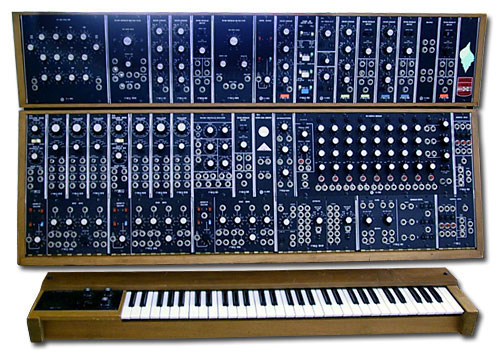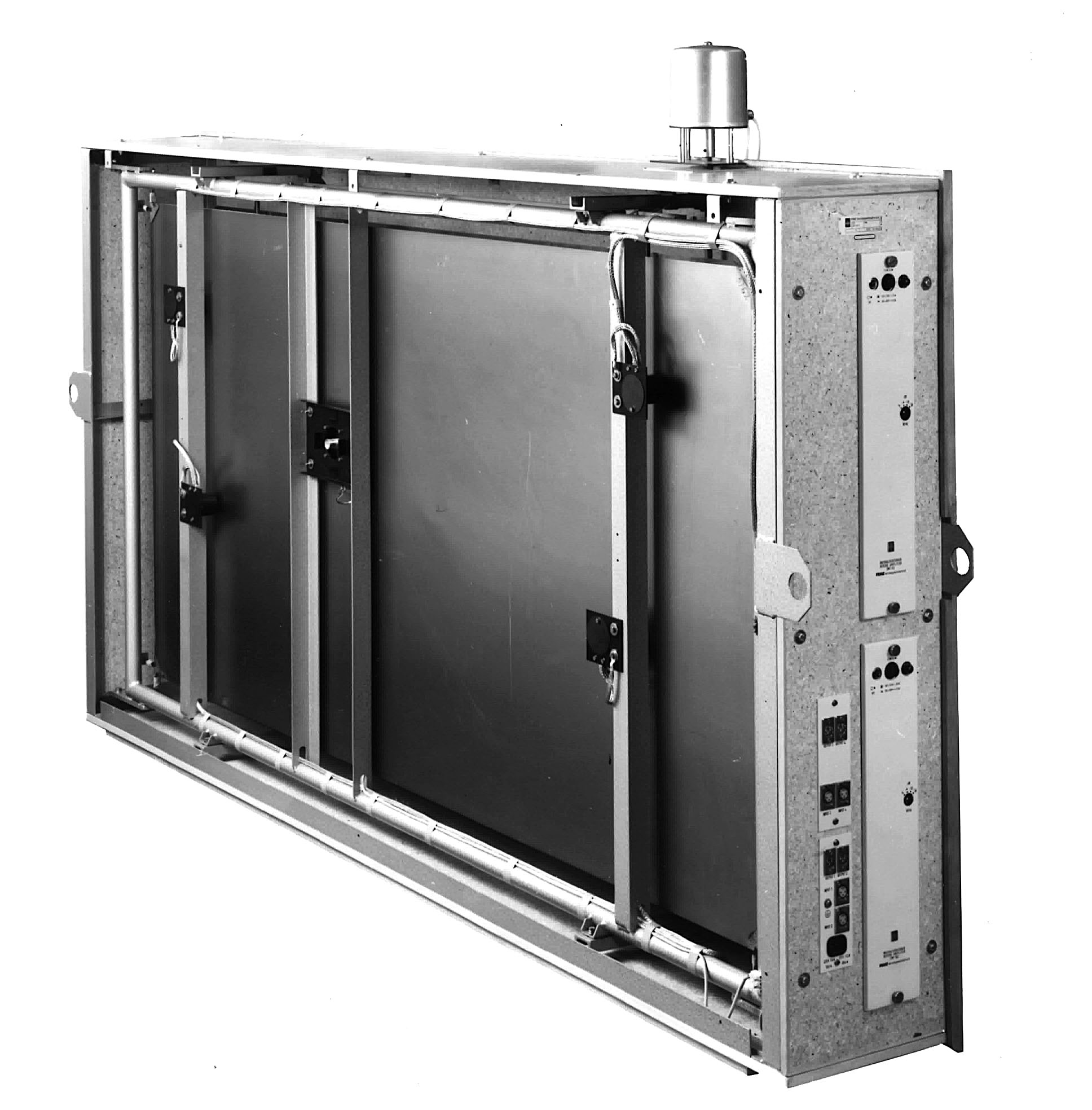|
ARP 2600
The ARP 2600 is a semi-modular analog subtractive audio synthesizer produced by ARP Instruments, Inc. History Developed by a design team headed by ARP namesake Allen R. Pearlman and engineer Dennis Colin, the ARP 2600 was introduced in 1971 as the successor to ARP's first instrument, the ARP 2500, at a retail price of US$2600. Unlike other modular systems of the time, which required modules to be purchased individually and wired by the user, the 2600 was semi-modular with a fixed selection of basic synthesizer components internally pre-wired, with clear text labels and front panel screen printed graphics indicating the function of different sections of controls, and the signal flow between them. The 2600 was thus ideal for musicians new to synthesis, due to its ability to be operated either with or without patch cords. On its initial release it was heavily marketed to high schools and universities. Features and architecture The ARP 2600 features three VCOs, a 4-pole (24 ... [...More Info...] [...Related Items...] OR: [Wikipedia] [Google] [Baidu] |
Ring Modulation
In electronics, ring modulation is a signal processing function, an implementation of frequency mixing, in which two signals are combined to yield an output signal. One signal, called the carrier, is typically a sine wave or another simple waveform; the other signal is typically more complicated and is called the input or the modulator signal. A ring modulator is an electronic device for ring modulation. A ring modulator may be used in music synthesizers and as an effects unit. The name derives from the fact that the analog circuit of diodes originally used to implement this technique takes the shape of a ring: a diode ring. The circuit is similar to a bridge rectifier, except that instead of the diodes facing left or right, they face clockwise or counterclockwise. Ring modulation is quite similar to amplitude modulation, with the difference that in the latter the modulator is shifted to be positive before being multiplied with the carrier, while in the former the unshi ... [...More Info...] [...Related Items...] OR: [Wikipedia] [Google] [Baidu] |
Edgar Winter
Edgar Holland Winter (born December 28, 1946) is an American musician. He is a multi-instrumentalist, playing keyboards, guitar, saxophone, and percussion, as well as singing. His success peaked in the 1970s with his band the Edgar Winter Group and their popular songs "Frankenstein" and " Free Ride". He is the brother of late blues singer and guitarist Johnny Winter. Early life Winter was born to John Winter II and Edwina Winter on December 28, 1946, in Beaumont, Texas. Both he and his older brother Johnny were born with albinism. By the time he left the family home, Winter had already mastered numerous instruments and reading and writing music. Career Winter composed and performed songs of numerous genres, including rock, jazz, blues, and pop. His critically acclaimed 1970 debut release, '' Entrance'', was first to demonstrate his unique style of non-sequitir, genre-blending musicianship. His early recording of " Tobacco Road" propelled him into the national spotlight. Edgar f ... [...More Info...] [...Related Items...] OR: [Wikipedia] [Google] [Baidu] |
Newton Highlands, Massachusetts
Newton Highlands is one of the thirteen villages within the city of Newton in Middlesex County, Massachusetts, United States. The Newton Highlands Historic District includes residential and commercial businesses back to the late 19th century. History John Haynes owned much of the land that is now Newton Highlands in 1635. He was the governor of the Massachusetts Bay Colony. The area was primarily farm land until train service was brought to the area. The Charles River Railroad extended its service in the Newton, Massachusetts area, from Brookline to Newton Highlands. It was called the Highlands Branch. Initially, train service was just for commercial traffic. In the 1870s, commuter service was extended from Boston to the village. The historic commuter suburb was platted after 1852 when the Charles River Railroad was first built. The streets included Floral, Lincoln, Walnut, and Hyde Streets. Land north of Lincoln Street was subdivided for more streets in 1871. As the village ... [...More Info...] [...Related Items...] OR: [Wikipedia] [Google] [Baidu] |
Voltage-controlled Filter
A voltage-controlled filter (VCF) is an electronic filter whose operating characteristics (primarily cutoff frequency) can be set by an input control voltage. Voltage controlled filters are widely used in synthesizers. A music synthesizer VCF allows its cutoff frequency, and sometimes its Q factor (resonance at the cutoff frequency), to be continuously varied. The filter outputs often include a lowpass response, and sometimes highpass, bandpass or notch responses. Some musical VCFs offer a variable ''slope'' which determines the rate of attenuation outside the bandpass, often at 6 dB/octave, 12 dB/octave, 18 dB/octave or 24 dB/octave (one-, two-, three- and four-pole filters, respectively). In modular analog synthesizers, VCFs receive signal input from signal sources, including oscillators and noise, or the output of other processors. By varying the cutoff frequency, the filter passes or attenuates partials of the input signal. In some popular electronic ... [...More Info...] [...Related Items...] OR: [Wikipedia] [Google] [Baidu] |
Robert Moog
Robert Arthur Moog ( ; May 23, 1934 – August 21, 2005) was an American engineer and electronic music pioneer. He was the founder of the synthesizer manufacturer Moog Music and the inventor of the first commercial synthesizer, the Moog synthesizer, which debuted in 1964. In 1970, Moog released a more portable model, the Minimoog, described as the most famous and influential synthesizer in history. Among Moog's honors are a Technical Grammy Award, received in 2002, and an induction into the National Inventors Hall of Fame. By 1963, Moog had been designing and selling theremins for several years, while working towards a PhD in engineering physics at Cornell University. He developed his synthesizer in response to demand for more practical and affordable electronic music equipment, guided by suggestions and requests from composers. Moog's principal innovation was the voltage-controlled oscillator, which uses voltage to control pitch. He also introduced fundamental synthesizer con ... [...More Info...] [...Related Items...] OR: [Wikipedia] [Google] [Baidu] |
Tom Oberheim
Thomas Elroy Oberheim (born July 7, 1936, Manhattan, Kansas), known as Tom Oberheim, is an American audio engineer and electronics engineer best known for designing effects processors, analog synthesizers, sequencers, and drum machines. He has been the founder of four audio electronics companies, most notably Oberheim Electronics. He was also a key figure in the development and adoption of the MIDI standard. He is also a trained physicist. Early life and education Oberheim was born and raised in Manhattan, Kansas, also the home of Kansas State University. Beginning in junior high school, he put his interest in electronics into practice by building hi-fi components and amplifiers for friends. A fan of jazz music, Oberheim decided to move to Los Angeles after seeing an ad on the back of ''Downbeat Magazine'' about free jazz performances at a club there. He arrived in Los Angeles in July 1956 at the age of 20 with $10 in his pocket. He worked as a draftsman trainee at NCR Corp ... [...More Info...] [...Related Items...] OR: [Wikipedia] [Google] [Baidu] |
Musical Keyboard
A musical keyboard is the set of adjacent depressible levers or keys on a musical instrument. Keyboards typically contain keys for playing the twelve notes of the Western musical scale, with a combination of larger, longer keys and smaller, shorter keys that repeats at the interval of an octave. Pressing a key on the keyboard makes the instrument produce sounds—either by mechanically striking a string or tine ( acoustic and electric piano, clavichord), plucking a string ( harpsichord), causing air to flow through a pipe organ, striking a bell ( carillon), or, on electric and electronic keyboards, completing a circuit ( Hammond organ, digital piano, synthesizer). Since the most commonly encountered keyboard instrument is the piano, the keyboard layout is often referred to as the ''piano keyboard''. Description The twelve notes of the Western musical scale are laid out with the lowest note on the left. The longer keys (for the seven "natural" notes of the C major scale ... [...More Info...] [...Related Items...] OR: [Wikipedia] [Google] [Baidu] |
ADSR Envelope '', the debut album from Simian Mobile Disco, released on June 18, 2007
{{disambiguation ...
ADSR may refer to: *ADSR envelope (attack decay sustain release), a common type of music envelope * Accelerator-driven sub-critical reactor, a nuclear reactor using a particle accelerator to generate a fission reaction in a sub-critical assembly of fissionable material * A.D.S.R. Musicwerks, a Seattle, Washington store and US record label that releases Synth Pop and Electro Industrial music *''Attack Decay Sustain Release ''Attack Decay Sustain Release'' is the debut album from Simian Mobile Disco. It was released on June 18, 2007 on Wichita Recordings and reached #59 in the UK album charts. History The title of the album is a reference to the ADSR envelope, ... [...More Info...] [...Related Items...] OR: [Wikipedia] [Google] [Baidu] |
Spring Reverb
A reverb effect, or reverb, is an audio effect applied to a sound signal to simulate reverberation. It may be created through physical means, such as echo chambers, or electronically through audio signal processing. Echo chambers The first reverb effects, introduced in the 1930s, were created by playing recordings through loudspeakers in reverberating spaces and recording the sound. American Producer Bill Putnam is credited for the first artistic use of artificial reverb in music, on the 1947 song "Peg o' My Heart" by the Harmonicats. Putnam placed a microphone and loudspeaker in the studio bathroom to create a natural echo chamber, adding an "eerie dimension". Plate reverb A plate reverb system uses an electromechanical transducer, similar to the driver in a loudspeaker, to create vibrations in a large plate of sheet metal. The plate's motion is picked up by one or more contact microphones whose output is an audio signal which may be added to the original "dry" signal. Pl ... [...More Info...] [...Related Items...] OR: [Wikipedia] [Google] [Baidu] |
Noise Generator
A noise generator is a circuit that produces electrical noise (i.e., a random signal). Noise generators are used to test signals for measuring noise figure, frequency response, and other parameters. Noise generators are also used for generating random numbers. Theory There are several circuits used for noise generation. For example, temperature-controlled resistors, temperature-limited vacuum diodes, zener diodes, and gas discharge tubes. A source that can be switched on and off ("gated") is beneficial for some test methods. Noise generators usually rely on a fundamental noise process such as thermal noise or shot noise. Thermal noise generator Thermal noise can be a fundamental standard. A resistor at a certain temperature has a thermal noise associated with it. A noise generator might have two resistors at different temperatures and switch between the two resistors. The resulting output power is low. (For a 1 kΩ resistor at room temperature and a 10 kHz bandwid ... [...More Info...] [...Related Items...] OR: [Wikipedia] [Google] [Baidu] |



